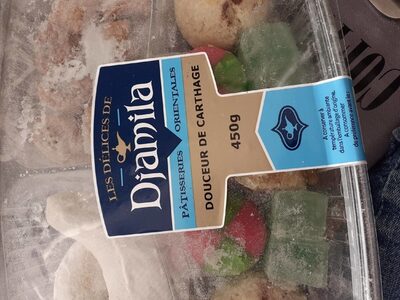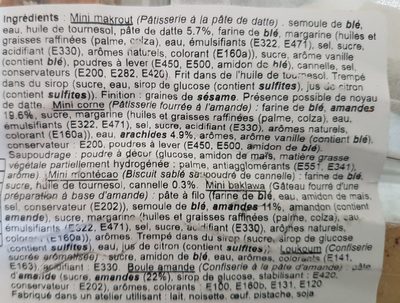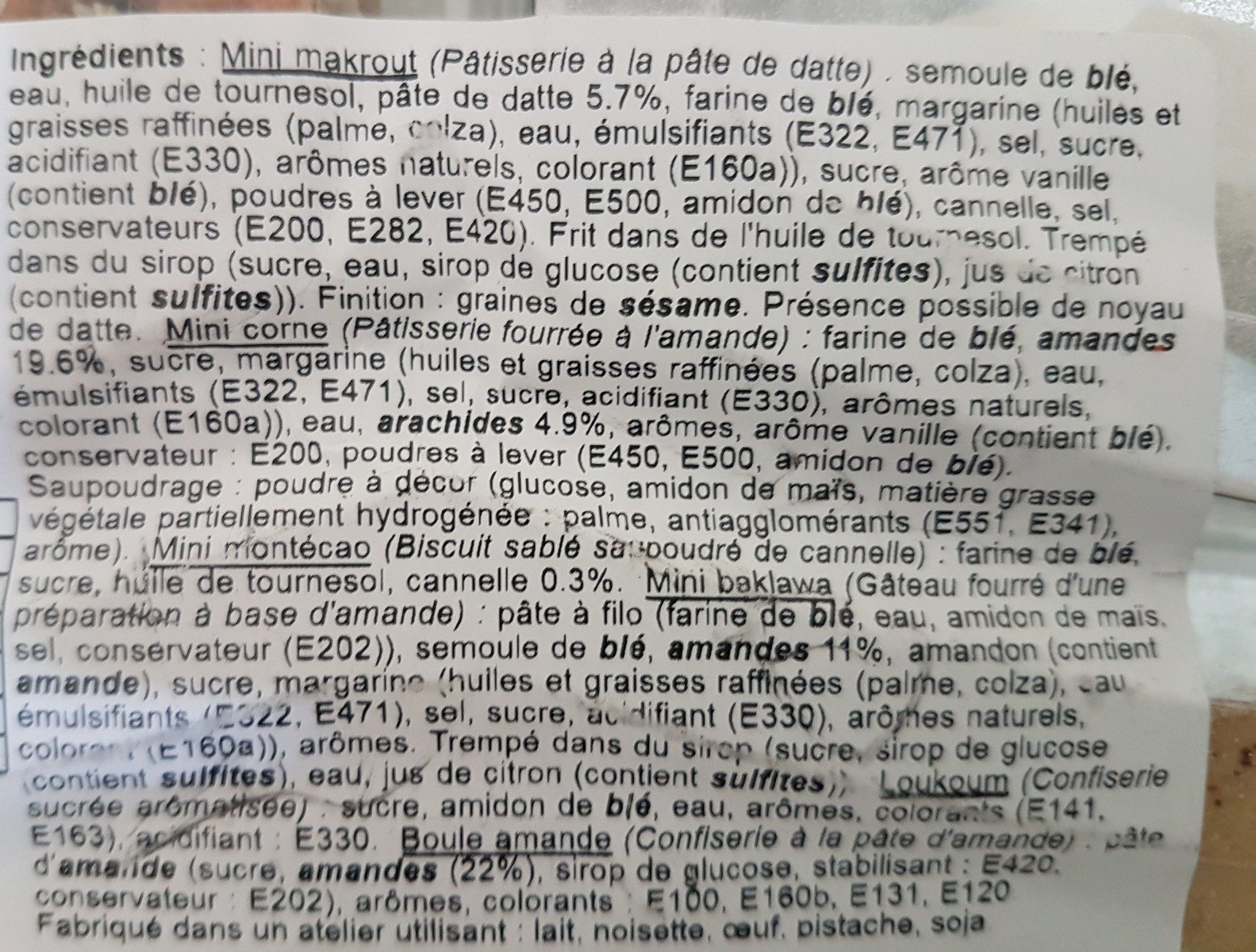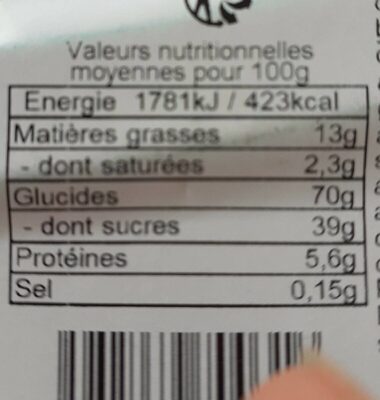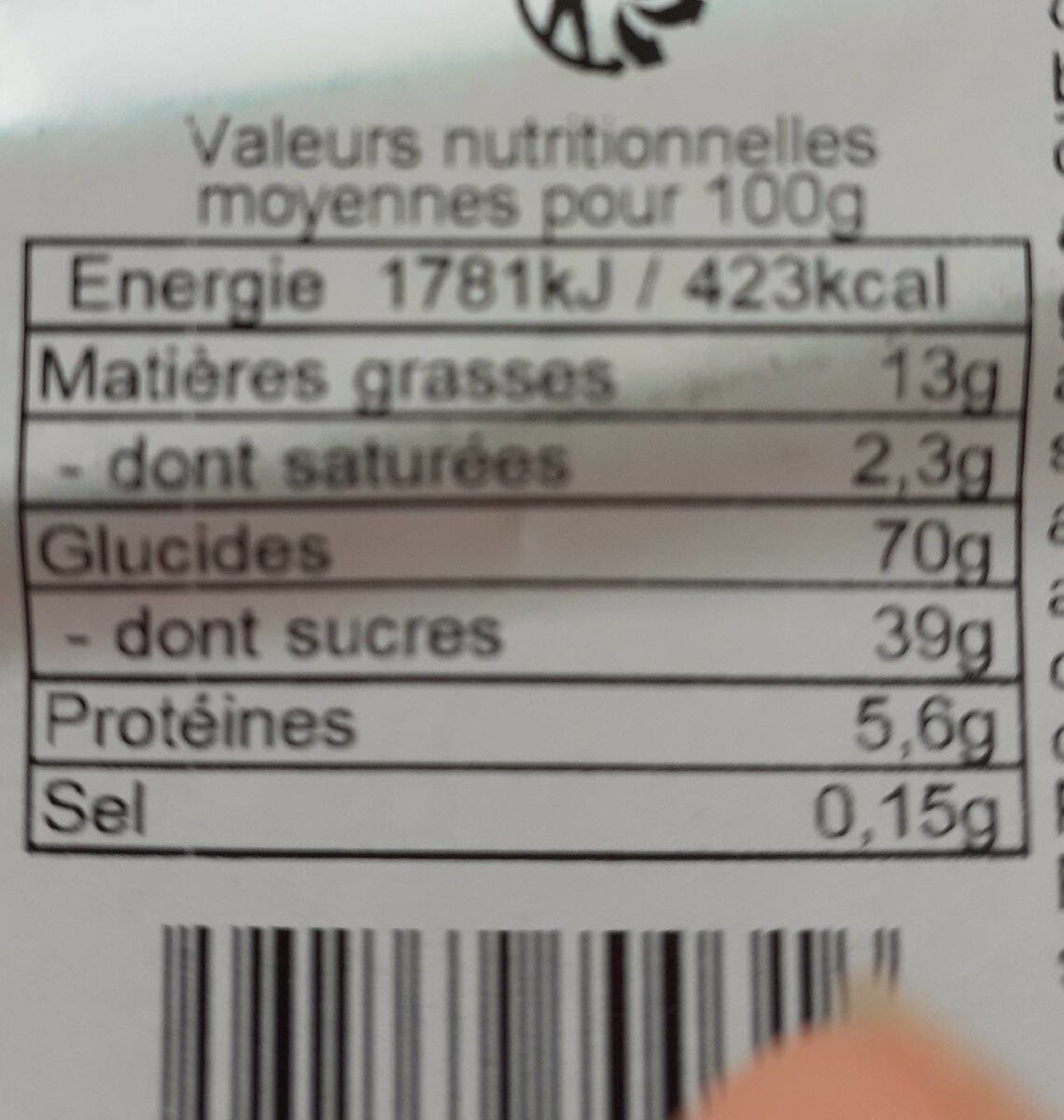Help us make food transparency the norm!
As a non-profit organization, we depend on your donations to continue informing consumers around the world about what they eat.
The food revolution starts with you!
Pâtisseries orientales - Les délices de Djamila - 450g
Pâtisseries orientales - Les délices de Djamila - 450g
This product page is not complete. You can help to complete it by editing it and adding more data from the photos we have, or by taking more photos using the app for Android or iPhone/iPad. Thank you!
×
Barcode: 3582739700316 (EAN / EAN-13)
Quantity: 450g
Brands: Les délices de Djamila
Countries where sold: France
Matching with your preferences
Health
Ingredients
-
150 ingredients
: Mini makrout (Pâtisserie à la pâte de datte). semoule de blé, eau, huile de tournesol, pâte de datte 5.7%, farine de blé, margarine (huiles et graisses raffinées (palme, colza), eau, émulsifiants (E322, E471), sel, sucre. acidifiant (E330), arômes naturels, colorant (E160a)), sucre, arôme vanille (contient blé), poudres à lever (E450, E500, amidon de blé), cannelle, sel, conservateurs (E200, E282, E420). Frit dans de l'huile de tournesol. Trempé dans du sirop (sucre, eau, sirop de glucose (contient sulfites), jus de citron (contient sulfites)). Finition graines de sésame. Présence possible de noyau de datte. Mini corne (Pâtisserie fourrée à l'amande): farine de blé, amandes 19.6%, sucre, margarine (huiles et graisses raffinées (palme, colza), eau, émulsifiants (E322, E471), sel, sucre, acidifiant (E330), arômes naturels, colorant (E160a)), eau, arachides 4.9%, arômes, arôme vanille (contient blé). conservateur: E200, poudres à lever (E450, E500, amidon de blé). Saupoudrage poudre à décor (glucose, amidon de mais, matière grasse végétale partiellement hydrogénée palme, antiagglomérants (E551, E341), arome) Mini montécao (Biscuit sablé sa poudré de cannelle): farine de blé. sucre, huile de tournesol, cannelle 0.3%. Mini baklawa (Gâteau fourré d'une préparation à base d'amande) pâte à filo (farine de blé, eau, amidon de maïs. sel, conservateur (E202)), semoule de blé, amandes 11%, amandon (contient amande), sucre, margarine (huiles et graisses raffinées (palme, colza), émulsifiants (322, E471), sel, sucre, acidifiant (E330), arômes naturels, colorant (E160a)), arômes. Trempé dans du sirop (sucre, sirop de glucose (contient sulfites), eau, jus de citron (contient sulfites) Loukoum (Confiserie sucrée aromatisee) sucre, amidon de blé, eau, arômes, colorants (E141. E163), acidifiant: E330. Boule amande (Confiserie à la pâte d'amande) pâte d'amanide (sucre, amandes (22%), sirop de glucose, stabilisant: E420. conservateur E202), arômes, colorants E100, E160b, E131, E120 Fabriqué dans un atelier utilisant: lait, noisette, ceuf, pistache, sojaAllergens: Gluten, Nuts, Peanuts, Sulphur dioxide and sulphitesTraces: Nuts, Soybeans
Food processing
-
Ultra processed foods
Elements that indicate the product is in the 4 - Ultra processed food and drink products group:
- Additive: E100 - Curcumin
- Additive: E131 - Patent blue v
- Additive: E141 - Copper complexes of chlorophylls and chlorophyllins
- Additive: E160a - Carotene
- Additive: E160b - Annatto
- Additive: E163 - Anthocyanins
- Additive: E322 - Lecithins
- Additive: E420 - Sorbitol
- Additive: E450 - Diphosphates
- Additive: E471 - Mono- and diglycerides of fatty acids
- Additive: E551 - Silicon dioxide
- Ingredient: Colour
- Ingredient: Emulsifier
- Ingredient: Flavouring
- Ingredient: Glucose
- Ingredient: Glucose syrup
Food products are classified into 4 groups according to their degree of processing:
- Unprocessed or minimally processed foods
- Processed culinary ingredients
- Processed foods
- Ultra processed foods
The determination of the group is based on the category of the product and on the ingredients it contains.
Additives
-
E131 - Patent blue v
Patent Blue V: Patent Blue V, also called Food Blue 5, Sulphan Blue, Acid Blue 3, L-Blau 3, C-Blau 20, Patentblau V, Sky Blue, or C.I. 42051 and is a dark bluish synthetic triphenylmethane dye used as a food coloring. As a food additive, it has E number E131. It is a sodium or calcium salt of [4--α--4-diethylaminophenyl--5-hydroxy- 2‚4-disulfophenylmethylidene--2‚5-cyclohexadien-1-ylidene] diethylammonium hydroxide inner salt.Source: Wikipedia
-
E160a - Carotene
Carotene: The term carotene -also carotin, from the Latin carota, "carrot"- is used for many related unsaturated hydrocarbon substances having the formula C40Hx, which are synthesized by plants but in general cannot be made by animals -with the exception of some aphids and spider mites which acquired the synthesizing genes from fungi-. Carotenes are photosynthetic pigments important for photosynthesis. Carotenes contain no oxygen atoms. They absorb ultraviolet, violet, and blue light and scatter orange or red light, and -in low concentrations- yellow light. Carotenes are responsible for the orange colour of the carrot, for which this class of chemicals is named, and for the colours of many other fruits, vegetables and fungi -for example, sweet potatoes, chanterelle and orange cantaloupe melon-. Carotenes are also responsible for the orange -but not all of the yellow- colours in dry foliage. They also -in lower concentrations- impart the yellow coloration to milk-fat and butter. Omnivorous animal species which are relatively poor converters of coloured dietary carotenoids to colourless retinoids have yellowed-coloured body fat, as a result of the carotenoid retention from the vegetable portion of their diet. The typical yellow-coloured fat of humans and chickens is a result of fat storage of carotenes from their diets. Carotenes contribute to photosynthesis by transmitting the light energy they absorb to chlorophyll. They also protect plant tissues by helping to absorb the energy from singlet oxygen, an excited form of the oxygen molecule O2 which is formed during photosynthesis. β-Carotene is composed of two retinyl groups, and is broken down in the mucosa of the human small intestine by β-carotene 15‚15'-monooxygenase to retinal, a form of vitamin A. β-Carotene can be stored in the liver and body fat and converted to retinal as needed, thus making it a form of vitamin A for humans and some other mammals. The carotenes α-carotene and γ-carotene, due to their single retinyl group -β-ionone ring-, also have some vitamin A activity -though less than β-carotene-, as does the xanthophyll carotenoid β-cryptoxanthin. All other carotenoids, including lycopene, have no beta-ring and thus no vitamin A activity -although they may have antioxidant activity and thus biological activity in other ways-. Animal species differ greatly in their ability to convert retinyl -beta-ionone- containing carotenoids to retinals. Carnivores in general are poor converters of dietary ionone-containing carotenoids. Pure carnivores such as ferrets lack β-carotene 15‚15'-monooxygenase and cannot convert any carotenoids to retinals at all -resulting in carotenes not being a form of vitamin A for this species-; while cats can convert a trace of β-carotene to retinol, although the amount is totally insufficient for meeting their daily retinol needs.Source: Wikipedia
-
E163 - Anthocyanins
Anthocyanin: Anthocyanins -also anthocyans; from Greek: ἄνθος -anthos- "flower" and κυάνεος/κυανοῦς kyaneos/kyanous "dark blue"- are water-soluble vacuolar pigments that, depending on their pH, may appear red, purple, or blue. Food plants rich in anthocyanins include the blueberry, raspberry, black rice, and black soybean, among many others that are red, blue, purple, or black. Some of the colors of autumn leaves are derived from anthocyanins.Anthocyanins belong to a parent class of molecules called flavonoids synthesized via the phenylpropanoid pathway. They occur in all tissues of higher plants, including leaves, stems, roots, flowers, and fruits. Anthocyanins are derived from anthocyanidins by adding sugars. They are odorless and moderately astringent. Although approved to color foods and beverages in the European Union, anthocyanins are not approved for use as a food additive because they have not been verified as safe when used as food or supplement ingredients. There is no conclusive evidence anthocyanins have any effect on human biology or diseases.Source: Wikipedia
-
E200 - Sorbic acid
Sorbic acid: Sorbic acid, or 2‚4-hexadienoic acid, is a natural organic compound used as a food preservative. It has the chemical formula CH3-CH-4CO2H. It is a colourless solid that is slightly soluble in water and sublimes readily. It was first isolated from the unripe berries of the Sorbus aucuparia -rowan tree-, hence its name.Source: Wikipedia
-
E202 - Potassium sorbate
Potassium sorbate (E202) is a synthetic food preservative commonly used to extend the shelf life of various food products.
It works by inhibiting the growth of molds, yeast, and some bacteria, preventing spoilage. When added to foods, it helps maintain their freshness and quality.
Some studies have shown that when combined with nitrites, potassium sorbate have genotoxic activity in vitro. However, potassium sorbate is generally recognized as safe (GRAS) by regulatory authorities.
-
E282 - Calcium propionate
Calcium propanoate: Calcium propanoate or calcium propionate has the formula Ca-C2H5COO-2. It is the calcium salt of propanoic acid.Source: Wikipedia
-
E322 - Lecithins
Lecithins are natural compounds commonly used in the food industry as emulsifiers and stabilizers.
Extracted from sources like soybeans and eggs, lecithins consist of phospholipids that enhance the mixing of oil and water, ensuring smooth textures in various products like chocolates, dressings, and baked goods.
They do not present any known health risks.
-
E330 - Citric acid
Citric acid is a natural organic acid found in citrus fruits such as lemons, oranges, and limes.
It is widely used in the food industry as a flavor enhancer, acidulant, and preservative due to its tart and refreshing taste.
Citric acid is safe for consumption when used in moderation and is considered a generally recognized as safe (GRAS) food additive by regulatory agencies worldwide.
-
E341 - Calcium phosphates
Calcium phosphate: Calcium phosphate is a family of materials and minerals containing calcium ions -Ca2+- together with inorganic phosphate anions. Some so-called calcium phosphates contain oxide and hydroxide as well. They are white solids of nutritious value.Source: Wikipedia
-
E420 - Sorbitol
Sorbitol: Sorbitol --, less commonly known as glucitol --, is a sugar alcohol with a sweet taste which the human body metabolizes slowly. It can be obtained by reduction of glucose, which changes the aldehyde group to a hydroxyl group. Most sorbitol is made from corn syrup, but it is also found in nature, for example in apples, pears, peaches, and prunes. It is converted to fructose by sorbitol-6-phosphate 2-dehydrogenase. Sorbitol is an isomer of mannitol, another sugar alcohol; the two differ only in the orientation of the hydroxyl group on carbon 2. While similar, the two sugar alcohols have very different sources in nature, melting points, and uses.Source: Wikipedia
-
E450 - Diphosphates
Diphosphates (E450) are food additives often utilized to modify the texture of products, acting as leavening agents in baking and preventing the coagulation of canned food.
These salts can stabilize whipped cream and are also found in powdered products to maintain their flow properties. They are commonly present in baked goods, processed meats, and soft drinks.
Derived from phosphoric acid, they're part of our daily phosphate intake, which often surpasses recommended levels due to the prevalence of phosphates in processed foods and drinks.
Excessive phosphate consumption is linked to health issues, such as impaired kidney function and weakened bone health. Though diphosphates are generally regarded as safe when consumed within established acceptable daily intakes, it's imperative to monitor overall phosphate consumption to maintain optimal health.
-
E471 - Mono- and diglycerides of fatty acids
Mono- and diglycerides of fatty acids (E471), are food additives commonly used as emulsifiers in various processed foods.
These compounds consist of glycerol molecules linked to one or two fatty acid chains, which help stabilize and blend water and oil-based ingredients. E471 enhances the texture and shelf life of products like margarine, baked goods, and ice cream, ensuring a smooth and consistent texture.
It is generally considered safe for consumption within established regulatory limits.
-
E500 - Sodium carbonates
Sodium carbonates (E500) are compounds commonly used in food preparation as leavening agents, helping baked goods rise by releasing carbon dioxide when they interact with acids.
Often found in baking soda, they regulate the pH of food, preventing it from becoming too acidic or too alkaline. In the culinary world, sodium carbonates can also enhance the texture and structure of foods, such as noodles, by modifying the gluten network.
Generally recognized as safe, sodium carbonates are non-toxic when consumed in typical amounts found in food.
-
E551 - Silicon dioxide
Silicon dioxide: Silicon dioxide, also known as silica, silicic acid or silicic acid anydride is an oxide of silicon with the chemical formula SiO2, most commonly found in nature as quartz and in various living organisms. In many parts of the world, silica is the major constituent of sand. Silica is one of the most complex and most abundant families of materials, existing as a compound of several minerals and as synthetic product. Notable examples include fused quartz, fumed silica, silica gel, and aerogels. It is used in structural materials, microelectronics -as an electrical insulator-, and as components in the food and pharmaceutical industries. Inhaling finely divided crystalline silica is toxic and can lead to severe inflammation of the lung tissue, silicosis, bronchitis, lung cancer, and systemic autoimmune diseases, such as lupus and rheumatoid arthritis. Uptake of amorphous silicon dioxide, in high doses, leads to non-permanent short-term inflammation, where all effects heal.Source: Wikipedia
Ingredients analysis
-
Palm oil
Ingredients that contain palm oil: Palm, Palm, Palm
-
Vegan status unknown
Unrecognized ingredients: fr:mini-makrout, fr:patisserie-a-la-pate-de-datte, Margarine, fr:frit-dans-de-l-huile-de-tournesol, fr:trempe-dans-du-sirop, fr:finition-graines-de-sesame, fr:mini-corne, fr:patisserie-fourree-a-l-amande, Margarine, fr:saupoudrage-poudre-a-decor, fr:matiere-grasse-vegetale-partiellement-hydrogenee-palme, fr:mini-montecao, fr:biscuit-sable-sa-poudre-de-cannelle, fr:mini-baklawa, fr:gateau-fourre-d-une-preparation-a-base-d-amande, fr:pate-a-filo, fr:amandon, Margarine, fr:322, fr:trempe-dans-du-sirop, fr:loukoum, fr:Confiserie, fr:boule-amande, fr:confiserie-a-la-pate-d-amande, fr:pate-d-amanide, fr:ceufSome ingredients could not be recognized.
We need your help!
You can help us recognize more ingredients and better analyze the list of ingredients for this product and others:
- Edit this product page to correct spelling mistakes in the ingredients list, and/or to remove ingredients in other languages and sentences that are not related to the ingredients.
- Add new entries, synonyms or translations to our multilingual lists of ingredients, ingredient processing methods, and labels.
If you would like to help, join the #ingredients channel on our Slack discussion space and/or learn about ingredients analysis on our wiki. Thank you!
-
Vegetarian status unknown
Unrecognized ingredients: fr:mini-makrout, fr:patisserie-a-la-pate-de-datte, Margarine, fr:frit-dans-de-l-huile-de-tournesol, fr:trempe-dans-du-sirop, fr:finition-graines-de-sesame, fr:mini-corne, fr:patisserie-fourree-a-l-amande, Margarine, fr:saupoudrage-poudre-a-decor, fr:matiere-grasse-vegetale-partiellement-hydrogenee-palme, fr:mini-montecao, fr:biscuit-sable-sa-poudre-de-cannelle, fr:mini-baklawa, fr:gateau-fourre-d-une-preparation-a-base-d-amande, fr:pate-a-filo, fr:amandon, Margarine, fr:322, fr:trempe-dans-du-sirop, fr:loukoum, fr:Confiserie, fr:boule-amande, fr:confiserie-a-la-pate-d-amande, fr:pate-d-amanide, fr:ceufSome ingredients could not be recognized.
We need your help!
You can help us recognize more ingredients and better analyze the list of ingredients for this product and others:
- Edit this product page to correct spelling mistakes in the ingredients list, and/or to remove ingredients in other languages and sentences that are not related to the ingredients.
- Add new entries, synonyms or translations to our multilingual lists of ingredients, ingredient processing methods, and labels.
If you would like to help, join the #ingredients channel on our Slack discussion space and/or learn about ingredients analysis on our wiki. Thank you!
-
Details of the analysis of the ingredients
We need your help!
Some ingredients could not be recognized.
We need your help!
You can help us recognize more ingredients and better analyze the list of ingredients for this product and others:
- Edit this product page to correct spelling mistakes in the ingredients list, and/or to remove ingredients in other languages and sentences that are not related to the ingredients.
- Add new entries, synonyms or translations to our multilingual lists of ingredients, ingredient processing methods, and labels.
If you would like to help, join the #ingredients channel on our Slack discussion space and/or learn about ingredients analysis on our wiki. Thank you!
: Mini makrout (Pâtisserie à la pâte de datte), semoule de blé, eau, huile de tournesol, pâte de datte 5.7%, farine de blé, margarine (huiles, graisses (palme, colza), eau, émulsifiants (e322, e471), sel, sucre, acidifiant (e330), arômes naturels, colorant (e160a)), sucre, arôme vanille, poudres à lever (e450, e500, amidon de blé), cannelle, sel, conservateurs (e200, e282, e420), Frit dans de l'huile de tournesol, Trempé dans du sirop (sucre, eau, sirop de glucose, jus de citron), Finition graines de sésame, Mini corne (Pâtisserie fourrée à l'amande, farine de blé), amandes 19.6%, sucre, margarine (huiles, graisses (palme, colza), eau, émulsifiants (e322, e471), sel, sucre, acidifiant (e330), arômes naturels, colorant (e160a)), eau, arachides 4.9%, arômes, arôme vanille, conservateur (e200), poudres à lever (e450, e500, amidon de blé), Saupoudrage poudre à décor (glucose, amidon de mais, matière grasse végétale partiellement hydrogénée palme, antiagglomérants (e551, e341), arome), Mini montécao (Biscuit sablé sa poudré de cannelle, farine de blé, sucre), huile de tournesol, cannelle 0.3%, Mini baklawa (Gâteau fourré d'une préparation à base d'amande), pâte à filo (farine de blé, eau, amidon de maïs, sel, conservateur (e202)), semoule de blé, amandes 11%, amandon, sucre, margarine (huiles, graisses (palme, colza), émulsifiants (322, e471), sel, sucre, acidifiant (e330), arômes naturels, colorant (e160a)), arômes, Trempé dans du sirop, sucre, sirop de glucose, eau, jus de citron, Loukoum (Confiserie), sucre, amidon de blé, eau, arômes, colorants (e141, e163), acidifiant (e330, Boule amande (Confiserie à la pâte d'amande), pâte d'amanide, sucre), amandes 22%, sirop de glucose, stabilisant (e420, conservateur), e202, arômes, colorants (e100), e160b, e131, ceuf, pistache, soja- Mini makrout -> fr:mini-makrout
- Pâtisserie à la pâte de datte -> fr:patisserie-a-la-pate-de-datte
- semoule de blé -> en:wheat-semolina - vegan: yes - vegetarian: yes - ciqual_proxy_food_code: 9610
- eau -> en:water - vegan: yes - vegetarian: yes - ciqual_food_code: 18066
- huile de tournesol -> en:sunflower-oil - vegan: yes - vegetarian: yes - from_palm_oil: no - ciqual_food_code: 17440
- pâte de datte -> en:date-paste - vegan: yes - vegetarian: yes - ciqual_food_code: 13011 - percent: 5.7
- farine de blé -> en:wheat-flour - vegan: yes - vegetarian: yes - ciqual_proxy_food_code: 9410
- margarine -> en:margarine
- huiles -> en:oil - vegan: maybe - vegetarian: maybe - from_palm_oil: maybe
- graisses -> en:fat - vegan: maybe - vegetarian: maybe - from_palm_oil: maybe
- palme -> en:palm - vegan: yes - vegetarian: yes - from_palm_oil: yes - ciqual_food_code: 16129
- colza -> en:colza-oil - vegan: yes - vegetarian: yes - from_palm_oil: no - ciqual_food_code: 17130
- eau -> en:water - vegan: yes - vegetarian: yes - ciqual_food_code: 18066
- émulsifiants -> en:emulsifier
- e322 -> en:e322 - vegan: maybe - vegetarian: maybe
- e471 -> en:e471 - vegan: maybe - vegetarian: maybe - from_palm_oil: maybe
- sel -> en:salt - vegan: yes - vegetarian: yes - ciqual_food_code: 11058
- sucre -> en:sugar - vegan: yes - vegetarian: yes - ciqual_proxy_food_code: 31016
- acidifiant -> en:acid
- e330 -> en:e330 - vegan: yes - vegetarian: yes
- arômes naturels -> en:natural-flavouring - vegan: maybe - vegetarian: maybe
- colorant -> en:colour
- e160a -> en:e160a - vegan: maybe - vegetarian: maybe - from_palm_oil: maybe
- sucre -> en:sugar - vegan: yes - vegetarian: yes - ciqual_proxy_food_code: 31016
- arôme vanille -> en:vanilla-flavouring - vegan: maybe - vegetarian: maybe
- poudres à lever -> en:raising-agent
- e450 -> en:e450 - vegan: yes - vegetarian: yes
- e500 -> en:e500 - vegan: yes - vegetarian: yes
- amidon de blé -> en:wheat-starch - vegan: yes - vegetarian: yes - ciqual_proxy_food_code: 9510
- cannelle -> en:cinnamon - vegan: yes - vegetarian: yes
- sel -> en:salt - vegan: yes - vegetarian: yes - ciqual_food_code: 11058
- conservateurs -> en:preservative
- e200 -> en:e200 - vegan: yes - vegetarian: yes
- e282 -> en:e282 - vegan: yes - vegetarian: yes
- e420 -> en:e420 - vegan: yes - vegetarian: yes
- Frit dans de l'huile de tournesol -> fr:frit-dans-de-l-huile-de-tournesol
- Trempé dans du sirop -> fr:trempe-dans-du-sirop
- sucre -> en:sugar - vegan: yes - vegetarian: yes - ciqual_proxy_food_code: 31016
- eau -> en:water - vegan: yes - vegetarian: yes - ciqual_food_code: 18066
- sirop de glucose -> en:glucose-syrup - vegan: yes - vegetarian: yes - ciqual_proxy_food_code: 31016
- jus de citron -> en:lemon-juice - vegan: yes - vegetarian: yes - ciqual_food_code: 2028
- Finition graines de sésame -> fr:finition-graines-de-sesame
- Mini corne -> fr:mini-corne
- Pâtisserie fourrée à l'amande -> fr:patisserie-fourree-a-l-amande
- farine de blé -> en:wheat-flour - vegan: yes - vegetarian: yes - ciqual_proxy_food_code: 9410
- amandes -> en:almond - vegan: yes - vegetarian: yes - ciqual_food_code: 15041 - percent: 19.6
- sucre -> en:sugar - vegan: yes - vegetarian: yes - ciqual_proxy_food_code: 31016
- margarine -> en:margarine
- huiles -> en:oil - vegan: maybe - vegetarian: maybe - from_palm_oil: maybe
- graisses -> en:fat - vegan: maybe - vegetarian: maybe - from_palm_oil: maybe
- palme -> en:palm - vegan: yes - vegetarian: yes - from_palm_oil: yes - ciqual_food_code: 16129
- colza -> en:colza-oil - vegan: yes - vegetarian: yes - from_palm_oil: no - ciqual_food_code: 17130
- eau -> en:water - vegan: yes - vegetarian: yes - ciqual_food_code: 18066
- émulsifiants -> en:emulsifier
- e322 -> en:e322 - vegan: maybe - vegetarian: maybe
- e471 -> en:e471 - vegan: maybe - vegetarian: maybe - from_palm_oil: maybe
- sel -> en:salt - vegan: yes - vegetarian: yes - ciqual_food_code: 11058
- sucre -> en:sugar - vegan: yes - vegetarian: yes - ciqual_proxy_food_code: 31016
- acidifiant -> en:acid
- e330 -> en:e330 - vegan: yes - vegetarian: yes
- arômes naturels -> en:natural-flavouring - vegan: maybe - vegetarian: maybe
- colorant -> en:colour
- e160a -> en:e160a - vegan: maybe - vegetarian: maybe - from_palm_oil: maybe
- eau -> en:water - vegan: yes - vegetarian: yes - ciqual_food_code: 18066
- arachides -> en:peanut - vegan: yes - vegetarian: yes - ciqual_food_code: 15001 - percent: 4.9
- arômes -> en:flavouring - vegan: maybe - vegetarian: maybe
- arôme vanille -> en:vanilla-flavouring - vegan: maybe - vegetarian: maybe
- conservateur -> en:preservative
- e200 -> en:e200 - vegan: yes - vegetarian: yes
- poudres à lever -> en:raising-agent
- e450 -> en:e450 - vegan: yes - vegetarian: yes
- e500 -> en:e500 - vegan: yes - vegetarian: yes
- amidon de blé -> en:wheat-starch - vegan: yes - vegetarian: yes - ciqual_proxy_food_code: 9510
- Saupoudrage poudre à décor -> fr:saupoudrage-poudre-a-decor
- glucose -> en:glucose - vegan: yes - vegetarian: yes - ciqual_proxy_food_code: 31016
- amidon de mais -> en:corn-starch - vegan: yes - vegetarian: yes - ciqual_food_code: 9510
- matière grasse végétale partiellement hydrogénée palme -> fr:matiere-grasse-vegetale-partiellement-hydrogenee-palme
- antiagglomérants -> en:anti-caking-agent
- e551 -> en:e551 - vegan: yes - vegetarian: yes
- e341 -> en:e341 - vegan: yes - vegetarian: yes
- arome -> en:flavouring - vegan: maybe - vegetarian: maybe
- Mini montécao -> fr:mini-montecao
- Biscuit sablé sa poudré de cannelle -> fr:biscuit-sable-sa-poudre-de-cannelle
- farine de blé -> en:wheat-flour - vegan: yes - vegetarian: yes - ciqual_proxy_food_code: 9410
- sucre -> en:sugar - vegan: yes - vegetarian: yes - ciqual_proxy_food_code: 31016
- huile de tournesol -> en:sunflower-oil - vegan: yes - vegetarian: yes - from_palm_oil: no - ciqual_food_code: 17440
- cannelle -> en:cinnamon - vegan: yes - vegetarian: yes - percent: 0.3
- Mini baklawa -> fr:mini-baklawa
- Gâteau fourré d'une préparation à base d'amande -> fr:gateau-fourre-d-une-preparation-a-base-d-amande
- pâte à filo -> fr:pate-a-filo
- farine de blé -> en:wheat-flour - vegan: yes - vegetarian: yes - ciqual_proxy_food_code: 9410
- eau -> en:water - vegan: yes - vegetarian: yes - ciqual_food_code: 18066
- amidon de maïs -> en:corn-starch - vegan: yes - vegetarian: yes - ciqual_food_code: 9510
- sel -> en:salt - vegan: yes - vegetarian: yes - ciqual_food_code: 11058
- conservateur -> en:preservative
- e202 -> en:e202 - vegan: yes - vegetarian: yes
- semoule de blé -> en:wheat-semolina - vegan: yes - vegetarian: yes - ciqual_proxy_food_code: 9610
- amandes -> en:almond - vegan: yes - vegetarian: yes - ciqual_food_code: 15041 - percent: 11
- amandon -> fr:amandon
- sucre -> en:sugar - vegan: yes - vegetarian: yes - ciqual_proxy_food_code: 31016
- margarine -> en:margarine
- huiles -> en:oil - vegan: maybe - vegetarian: maybe - from_palm_oil: maybe
- graisses -> en:fat - vegan: maybe - vegetarian: maybe - from_palm_oil: maybe
- palme -> en:palm - vegan: yes - vegetarian: yes - from_palm_oil: yes - ciqual_food_code: 16129
- colza -> en:colza-oil - vegan: yes - vegetarian: yes - from_palm_oil: no - ciqual_food_code: 17130
- émulsifiants -> en:emulsifier
- 322 -> fr:322
- e471 -> en:e471 - vegan: maybe - vegetarian: maybe - from_palm_oil: maybe
- sel -> en:salt - vegan: yes - vegetarian: yes - ciqual_food_code: 11058
- sucre -> en:sugar - vegan: yes - vegetarian: yes - ciqual_proxy_food_code: 31016
- acidifiant -> en:acid
- e330 -> en:e330 - vegan: yes - vegetarian: yes
- arômes naturels -> en:natural-flavouring - vegan: maybe - vegetarian: maybe
- colorant -> en:colour
- e160a -> en:e160a - vegan: maybe - vegetarian: maybe - from_palm_oil: maybe
- arômes -> en:flavouring - vegan: maybe - vegetarian: maybe
- Trempé dans du sirop -> fr:trempe-dans-du-sirop
- sucre -> en:sugar - vegan: yes - vegetarian: yes - ciqual_proxy_food_code: 31016
- sirop de glucose -> en:glucose-syrup - vegan: yes - vegetarian: yes - ciqual_proxy_food_code: 31016
- eau -> en:water - vegan: yes - vegetarian: yes - ciqual_food_code: 18066
- jus de citron -> en:lemon-juice - vegan: yes - vegetarian: yes - ciqual_food_code: 2028
- Loukoum -> fr:loukoum
- Confiserie -> fr:confiserie
- sucre -> en:sugar - vegan: yes - vegetarian: yes - ciqual_proxy_food_code: 31016
- amidon de blé -> en:wheat-starch - vegan: yes - vegetarian: yes - ciqual_proxy_food_code: 9510
- eau -> en:water - vegan: yes - vegetarian: yes - ciqual_food_code: 18066
- arômes -> en:flavouring - vegan: maybe - vegetarian: maybe
- colorants -> en:colour
- e141 -> en:e141 - vegan: yes - vegetarian: yes
- e163 -> en:e163 - vegan: yes - vegetarian: yes
- acidifiant -> en:acid
- e330 -> en:e330 - vegan: yes - vegetarian: yes
- Boule amande -> fr:boule-amande
- Confiserie à la pâte d'amande -> fr:confiserie-a-la-pate-d-amande
- pâte d'amanide -> fr:pate-d-amanide
- sucre -> en:sugar - vegan: yes - vegetarian: yes - ciqual_proxy_food_code: 31016
- amandes -> en:almond - vegan: yes - vegetarian: yes - ciqual_food_code: 15041 - percent: 22
- sirop de glucose -> en:glucose-syrup - vegan: yes - vegetarian: yes - ciqual_proxy_food_code: 31016
- stabilisant -> en:stabiliser
- e420 -> en:e420 - vegan: yes - vegetarian: yes
- conservateur -> en:preservative
- e202 -> en:e202 - vegan: yes - vegetarian: yes
- arômes -> en:flavouring - vegan: maybe - vegetarian: maybe
- colorants -> en:colour
- e100 -> en:e100 - vegan: yes - vegetarian: yes
- e160b -> en:e160b - vegan: yes - vegetarian: yes
- e131 -> en:e131 - vegan: yes - vegetarian: yes
- ceuf -> fr:ceuf
- pistache -> en:pistachio-nuts - vegan: yes - vegetarian: yes - ciqual_food_code: 15044
- soja -> en:soya - vegan: yes - vegetarian: yes
Nutrition
-
Missing data to compute the Nutri-Score
Missing category
⚠ ️The category of the product must be specified in order to compute the Nutri-Score.Could you add the information needed to compute the Nutri-Score? Add a category
-
Nutrition facts
Nutrition facts As sold
for 100 g / 100 mlEnergy 1,770 kj
(423 kcal)Fat 13 g Saturated fat 2.3 g Carbohydrates 70 g Sugars 39 g Fiber ? Proteins 0 g Salt 0 g Fruits‚ vegetables‚ nuts and rapeseed‚ walnut and olive oils (estimate from ingredients list analysis) 63.217 %
Environment
-
Eco-Score not computed - Unknown environmental impact
We could not compute the Eco-Score of this product as it is missing some data, could you help complete it?Could you add a precise product category so that we can compute the Eco-Score? Add a category
Packaging
-
Missing packaging information for this product
⚠ ️ The information about the packaging of this product is not filled in.Take a photo of the recycling information Take a photo of the recycling information
Transportation
-
Origins of ingredients
Missing origins of ingredients information
⚠ ️ The origins of the ingredients of this product are not indicated.
If they are indicated on the packaging, you can modify the product sheet and add them.
If you are the manufacturer of this product, you can send us the information with our free platform for producers.Add the origins of ingredients for this product Add the origins of ingredients for this product
Threatened species
-
Contains palm oil
Drives deforestation and threatens species such as the orangutan
Tropical forests in Asia, Africa and Latin America are destroyed to create and expand oil palm tree plantations. The deforestation contributes to climate change, and it endangers species such as the orangutan, the pigmy elephant and the Sumatran rhino.
Report a problem
-
Incomplete or incorrect information?
Category, labels, ingredients, allergens, nutritional information, photos etc.
If the information does not match the information on the packaging, please complete or correct it. Open Food Facts is a collaborative database, and every contribution is useful for all.
Data sources
Product added on by kiliweb
Last edit of product page on by emefit.
Product page also edited by openfoodfacts-contributors, yuka.MatmbdisHO05Dsrt994ojDySGsKxOOZ9GyVQog, yuka.YlA1WkY2RTRyOUlxbDhFeTN6cnhwZXBVNUthTUFtSHFMdTB4SUE9PQ, yuka.sY2b0xO6T85zoF3NwEKvlm9CSOTSoRuVJkbuwRSW3oqkL4DpZdMqzZPKFKs.
